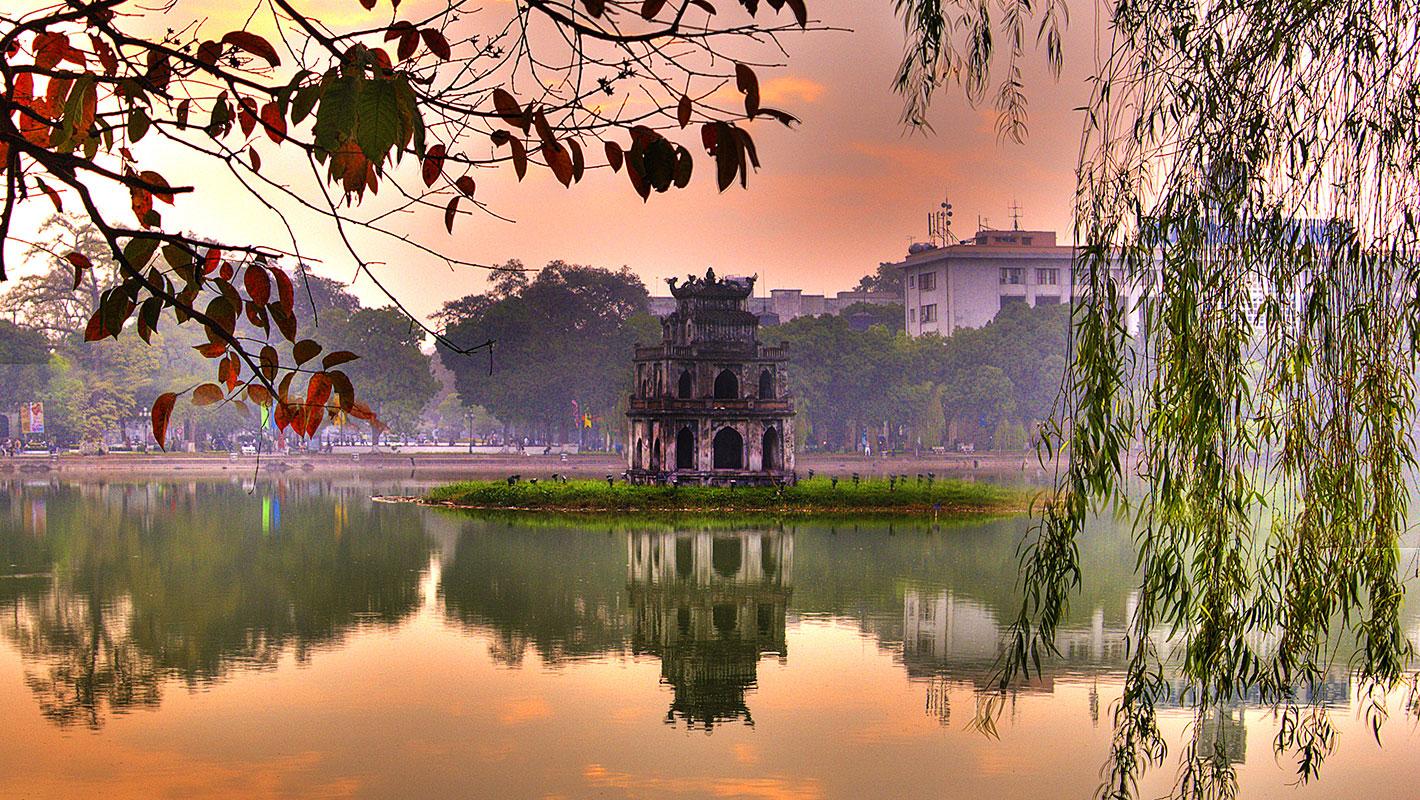
HOAN KIEM LAKE – A MUST-SEE ATTRACTION IN HANOI
A national relic and cultural icon in the heart of Hanoi, Hoan Kiem Lake has witnessed many ups and downs in Hanoi’s history. Undeniably, Hoan Kiem Lake is a must-visit destination for travelers when coming to Hanoi.
Turtle Tower
 Turtle Tower - a three-storey tower on a large heap of land in the heart of Hoan Kiem Lake, about 350 square meters wide, is a unique combination of local Vietnamese and French colonial architecture and a sacred cultural-spiritual of Hanoi. The tower, built in 1886, gradually narrows to the top since its first two storeys are larger than the third one. The ground and first floors own three doors on the Eastern and Western sides, while two other doors are visible on the Southern and Northern sides. The first and the top floors are fenced with horizontal and vertical rails. A thrilling point lies in the mythical existence of giant hundred-year-old turtles living in Hoan Kiem Lake, by Turtle Tower. In the past, four turtles died: One in 1962 at the Chi Linh flower garden, one is stored in the Hanoi Museum, the other preserved in Ngoc Son Temple, and the last turtle passed away in 2016 and mummified on display at the Vietnam National Museum of Natural History.
Turtle Tower - a three-storey tower on a large heap of land in the heart of Hoan Kiem Lake, about 350 square meters wide, is a unique combination of local Vietnamese and French colonial architecture and a sacred cultural-spiritual of Hanoi. The tower, built in 1886, gradually narrows to the top since its first two storeys are larger than the third one. The ground and first floors own three doors on the Eastern and Western sides, while two other doors are visible on the Southern and Northern sides. The first and the top floors are fenced with horizontal and vertical rails. A thrilling point lies in the mythical existence of giant hundred-year-old turtles living in Hoan Kiem Lake, by Turtle Tower. In the past, four turtles died: One in 1962 at the Chi Linh flower garden, one is stored in the Hanoi Museum, the other preserved in Ngoc Son Temple, and the last turtle passed away in 2016 and mummified on display at the Vietnam National Museum of Natural History.
The Huc Bridge
Entering Ngoc Son Temple, visitors will come across The Huc Bridge (The Bridge of the Rising Sun) and walk through Tam Quan (Three-passage Gate). Outside the first gate are two Chinese letters indicating Phuc (Happiness) on the right and Loc (Prosperity) on the left. The Bridge, painted in bright red, which resembles life, hope, and the Sun, has 32 circular pillars made from concrete, wooden floor, and railings, with a touch of parallel and ancient architecture.

The Pen Tower
Behind the first gate of Ngoc Son Temple is Pen Tower (Thap But), a 28m five-storey architecture made from stones and located on Doc Ton Mountain dedicated to literature and poetry. The peak of the Tower has the shape of a feather quill pen pointing toward the sky. Its body is hand-carved with three letters “Ta Thanh Thien” (Written on the clear blue sky), followed by a large Fengshui construction: A second gate with Taoist symbols, also Dragon symbol on the right and Tiger symbol on the left. The last gate has a high wall, roof, and rolling doors. On the roof, there is a large stone representing an ink pot, named Dai Nghien (the Writing Pad or the Ink-slab).

Ly Thai To Monument

The Ly Thai To monument is a large bronze sculpture of Emperor Ly Thai To, the founder of the Ly Dynasty and Thang Long Imperial City since 1010, which later became the city of Hanoi. The bronze statue weighs 12 tons, stands at 10.10 meters, and is atop a 20-ton pedestal. The right hand of Ly Thai To holds the Chieu Doi Do (The Decree of the Relocation of the Capital City to Thang Long), and the left-hand points to the location where the construction began. The statue was erected to celebrate the 50th anniversary of the liberation of Hanoi. It is venerated by the local people with flowers and incense. The monument of Ly Thai To is opposite Hoan Kiem Lake, located in Indira Gandhi Park (Dinh Tien Hoang Street), named after the slain Indian prime minister who was a supporter and friend of Vietnam.
Link nội dung: https://cdsphagiang.edu.vn/hoan-kiem-lake-is-an-attractive-a73768.html